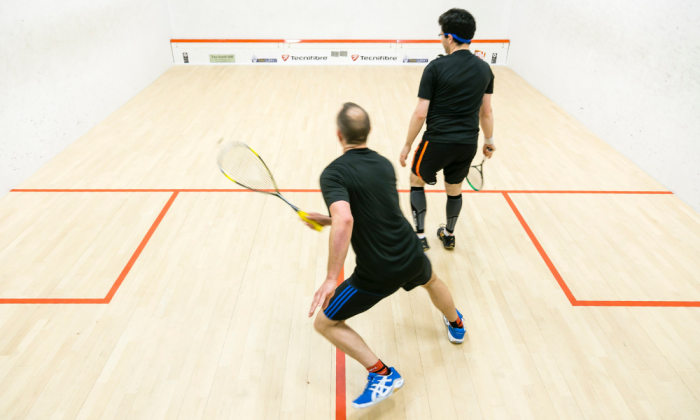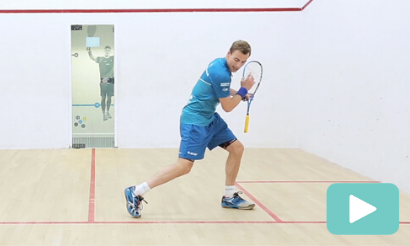When I watch and observe amateur players it becomes pretty evident that amateur players often make reactive decisions when their opponent is hitting the ball. Everything gets done in compartmentalized blocks starting from the movement, through to the execution of the shot and then finally to the response to their opponents shot. Having to deal with the game in all these separate compartments is hard. It will take time away from yourself, it is mentally and physically exhausting, and then when it comes to the execution of your own shot, it is it limits your tactical options.
This is one of the best videos from Lee Drew explaining some key areas about what to watch in order to become more proactive with your game.
Below are some strategies to become aware of and to try and incorporate into your games, bit by bit, in order to help improve a more proactive approach to your game of squash.
Use your movement through the shot
To start with, it is worthwhile training the ability to use your movement through your shot, so you are able to get back to a relatively central position in the court. Very often an amateur player will be so focused on the execution of the shot that they tend to stabilize, stay very still, try and balance, hit the ball and then stay in and around the area of the shot for longer than is necessary. I am a big believer in being able to complete your shot to the highest quality possible, but if the tradeoff of stillness is too big then you will get stuck close to where you have just hit from and leaving yourself exposed as your opponent moves onto your shot. The better players are leaving the area they have hit very soon after contacting the ball and this is done by having movement from the body transferring through the shot as well as using the follow-through to aid recovery.
 Observe your shot quality
Observe your shot quality
Once you have executed your shot, ideally to a decent enough quality, start to really observe what is going on. I sometimes see the amateur player hitting a 7 or 8 out of 10 quality shot and then stand and just admire it without any response to the shot. Playing a high-level shot should then prompt you to move to a part of the court that is positive and commanding. Generally, the T area but also trying to cut off angles and options for your opponent. Such a common fault is a high level of shot execution and then a bad T positioning giving your opponent an easier chance to get themselves out of trouble.
Pick up cues from your opponent
Once you have completed your shot, the next bit of information you should look to the process would be your opponent and how they are addressing the ball to hit their next shot. Again a very common fault is ‘ball watching’. It is good to watch the ball, but at a certain point, the information the ball will give you is limited and no longer of use. However, how your opponent is moving to the ball and what they are shaping up to play is where the rest of the information will be coming from. Use this information about their body shape and angle to predict where you think they may hit. Look for the obvious clues at first, such as a boast or defensive shot and over time you should be able to spot the more subtle cues when they have a lot of options to choose from.
Take up a floating T position
Once you have done all the above it is now time to move to a part of the court where you have assessed the odds and the likelihood of the shot going to that part of the court. In simple terms, this is called a ‘floating T’ and is an around the T zone but that would be also favouring one area of the court you would predict the ball may travel to. You are now limiting your opponent’s options, as well as cutting down their time if they play the shot to where you think it may end up. You may get this wrong at times in the early stages of learning, but do persist with this as you will start to appreciate where to stand, and in doing so, make your opponent’s life a bit of a misery.
 Premeditate the ball strike with movement
Premeditate the ball strike with movement
When predicting where the next shot will go, you will now need to create some momentum with your movement. Try and not to spread your base too wide and become flat-footed. If you just watch proceedings unfold, you will be caught short. Work on developing a well-timed and natural split-step as you move to your opponent’s ball. This initial engagement really does help the proactive state of mind for amateur players. If the body is engaging as your opponent is striking the ball, you’ll start to feel an advantage when it comes to getting onto the ball quickly.
Build up a database of responses
Now that you are observing more efficiently and making more proactive decisions, you need to learn to process the information. You will need to be conscious of this to begin with, but with time you will have seen enough of the same situations and dealt with enough of the same responses from opponents, that you will start to know where that ball should be travelling to. Work on picking up some of the easier and more obvious responses first. Over time, the subtler and harder to spot ones will become easier to deal with, as brain becomes tuned into capturing, storing and reacting to previous experiences.
Making all these changes in one go is a big ask. Try and pick one of these above areas and fine-tune it as best you can. It will begin to creep into your subconscious, as you become more confident you can start to introduce more of the other strategies. You do need to give yourself time to learn these proactive responses and there is no quick fix to this. Squash requires experience.
By being smart and doing things with more efficiency, even when playing someone who is faster and fitter than you, you will be able to frustrate them and see shots before they happen. Take a proactive approach to this and try to make your movement and decision making less reactive. Bit by bit and these small gains will add up to a lot of improvement over time.
Jesse Engelbrecht
Want to learn more about common amateur faults?
Check out the series where Jesse discusses some common technical and tactical amateur faults, explaining how to make small adjustments that will vastly improve your performances on court.
Watch now